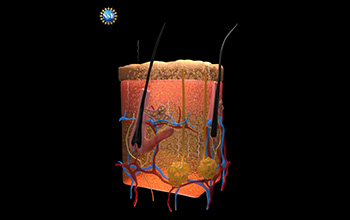Multimedia Gallery
Skin tissues rendered transparent following saturation by dye
Researchers have developed a new process -- a topical application of food-safe dye -- to see organs within a body by rendering overlying tissues transparent to visible light. In this illustration, skin tissues are rendered transparent following saturation by FD&C Yellow 5, including the paths of photons reflecting off undyed tissues.
[Research supported by U.S. National Science Foundation grants ECCS 1542152, CBET 2045120, CBET 2217582 and DGE 1656518.]
Learn more in the NSF news story A window into the body: groundbreaking technique makes skin transparent. (Date of image: 2024; date originally posted to NSF Multimedia Gallery: Sept. 6, 2024)
Credit: Keyi "Onyx" Li/U.S. National Science Foundation
Images and other media in the National Science Foundation Multimedia Gallery are available for use in print and electronic material by NSF employees, members of the media, university staff, teachers and the general public. All media in the gallery are intended for personal, educational and nonprofit/non-commercial use only.
Images credited to the National Science Foundation, a federal agency, are in the public domain. The images were created by employees of the United States Government as part of their official duties or prepared by contractors as "works for hire" for NSF. You may freely use NSF-credited images and, at your discretion, credit NSF with a "Courtesy: National Science Foundation" notation.
Additional information about general usage can be found in Conditions.
Also Available:
Download the high-resolution JPG version of the image. (1.2 MB)
Use your mouse to right-click (Mac users may need to Ctrl-click) the link above and choose the option that will save the file or target to your computer.

 All images in this series
All images in this series